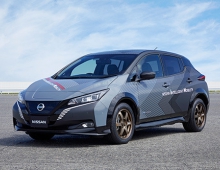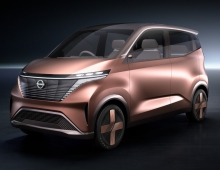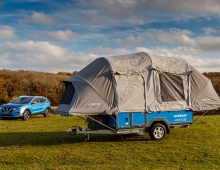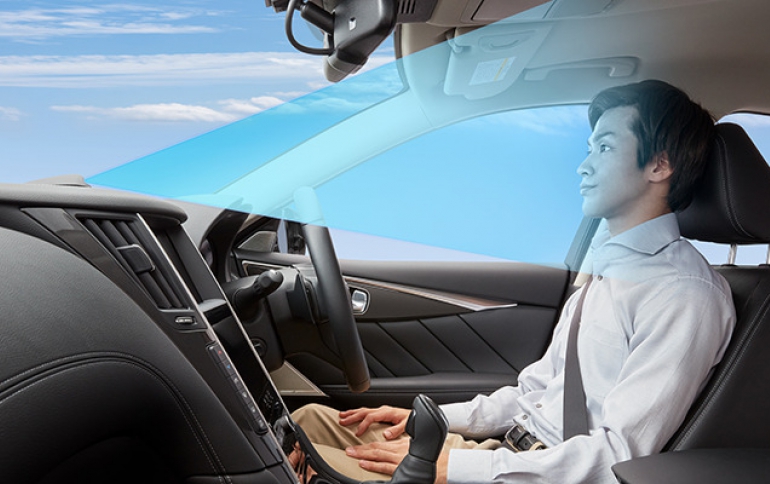
Nissan Skyline to Feature New Driver Assistance System
Nissan today unveiled a new driver assistance technology, combining navigated highway driving with hands-off single-lane driving capabilities.
Expanding on the company's ProPILOT system, the technology will debut on the Japanese-market Nissan Skyline in the fall of 2019.
Designed for on-ramp to off-ramp (ramp-to-ramp) highway driving, the new system engages with the vehicle's navigation system to help maneuver the car according to a predefined route on designated roadways. For the first time, the system also enables hands-off driving while cruising in a single lane. Hands-off driving is possible when driving in a single lane, on the condition that the driver remains attentive on the road ahead and is prepared to immediately take manual control of the steering wheel when conditions of the road, traffic and vehicle require it. In addition, Nissan clarified that the hands-off feature is not available in tunnels where a GPS signal cannot be established, on expressways that have two-way traffic, on winding roads, in tollgate areas or merging lanes. When entering a road section where hands-off driving is not available, the system will alert in advance so the driver can take manual control of vehicle steering.
To enable the latest functions of the new system, drivers must first set their destination in the navigation system, creating a predefined travel route. Once the car enters the highway, the new system's navigated driving becomes available.
Upon activation using a predefined route, the system will assist the driver with traveling on a multi-lane highway until reaching the highway exit on a predefined route — helping to handle passing, lane diversions and lane exiting.
The new ProPILOT also enables hands-off driving while cruising in a given lane. When the vehicle approaches a road divide, or when passing a slower vehicle is possible, the system judges the appropriate timing of branching off or passing based on information from the navigation system and 360-degree sensing. Audio and visual guidance is given to the driver, who is prompted to put both hands on the steering wheel and confirm the start of these operations with a switch.
The vehicle uses a combination of cameras, radars, sonars, GPS and 3D high-definition map data (HD map) to provide 360-degree, real-time information of the surrounding environment and the vehicle's precise location on the road. A monitoring system in the cabin continually confirms that the driver's attention is on the road.
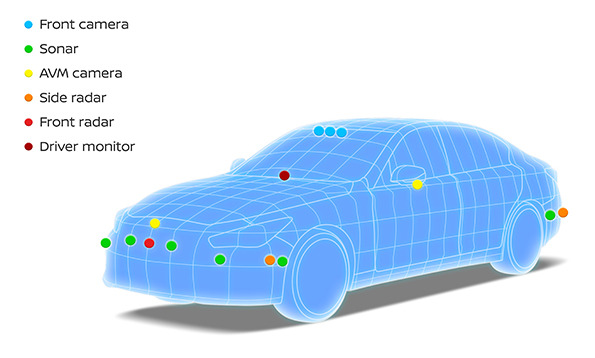
Nissan is sticking to self-driving technology which uses radar sensors and cameras, avoiding lidar or light-based sensors because of their high cost and limited capabilities.
Nissan, which wants to have its self-driving cars on city streets by 2020, has long shunned lidar, a relatively new technology for automobiles which has recently been the subject of an influx in investment by many of its rivals.
Tesla also relies on cameras and radars for its self-driving technology.
Lidar is currently used by companies including General Motors Co, Ford Motor Co and Alphabet Inc’s Waymo as automakers and tech firms race to develop self-driving cars.
Lidar technology uses light-based sensors that fire roughly 1 million laser pulses a second as it collects measurements that are analyzed and processed into 3D models and maps.
Initially using bulky spinning devices placed on the roof of cars, lidar developers have transitioned to more compact solid-state devices that can be mounted on other parts of a car. These now sell for less than $10,000 in limited quantities, and are widely expected to eventually sell for as little as $200 in mass production.
Main use scenarios of ProPILOT
Audio cues and visual notifications alert the driver when the navigated driving feature becomes available (upon entering the highway and using a predefined route set in the navigation system).
The driver can start navigated driving by operating a switch. Once activated, the system will help drive the vehicle in the center of a given lane and maintain a certain distance with the preceding vehicle, keeping within a speed set by the driver.
Hands-off driving is possible when driving in a single lane as long as the driver's attention is on the road ahead and the driver is prepared to take manual control of the steering wheel when conditions of the road, traffic and vehicle require it.
If the preceding vehicle is driving more slowly than the speed set by the driver, and the system detects that it can pass, the driver will be notified through audio and visual guidance. The driver can agree to pass by placing both hands on the steering wheel and operating a switch. Upon the driver's confirmation, the vehicle will smoothly move into the passing lane. Once it has passed the slower vehicle and the system has determined that it is possible to return to the driving lane, the system requests confirmation from the driver to bring the vehicle back into the original lane.
When wishing to initiate a lane change, the driver places both hands on the steering wheel and activates the turn signal. The vehicle will change lanes once the system has determined that a lane change is possible.
When the vehicle approaches the highway exit of a predefined route, audio and visual guidance is given to notify the driver that navigated driving is about to end. Once the vehicle reaches the highway exit ramp, navigated driving is disengaged and the driver takes full control of the vehicle.


